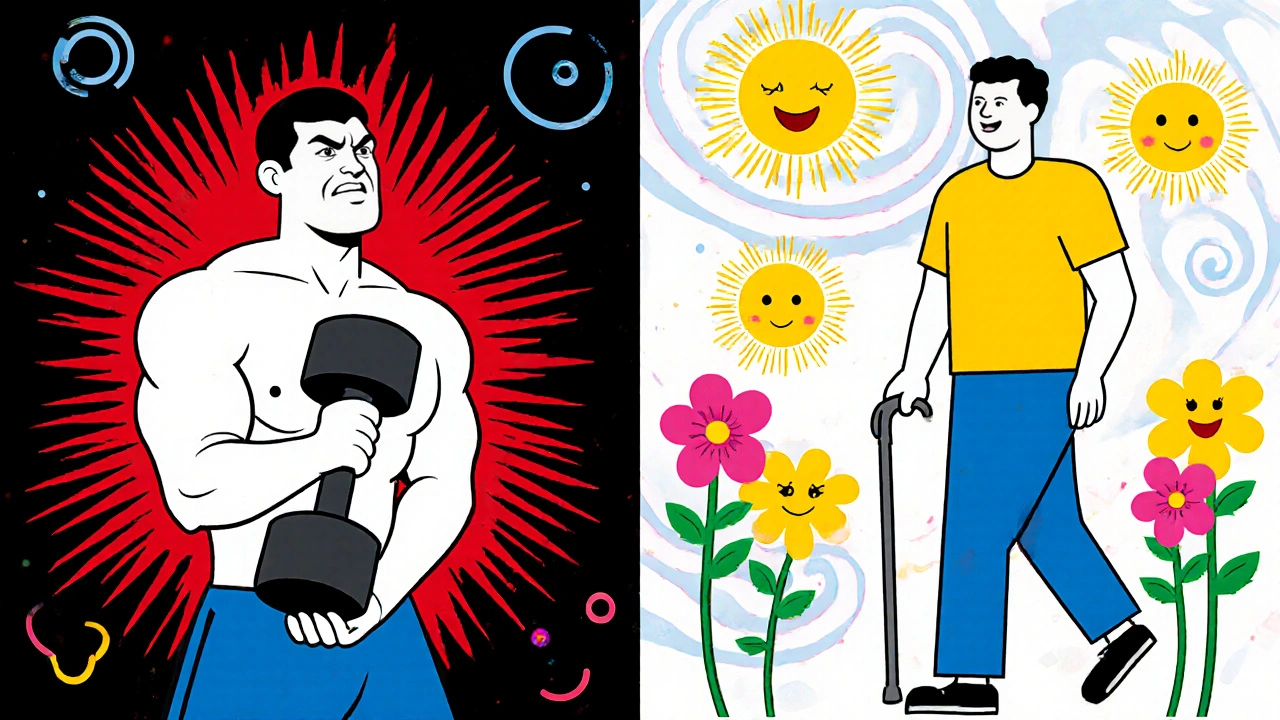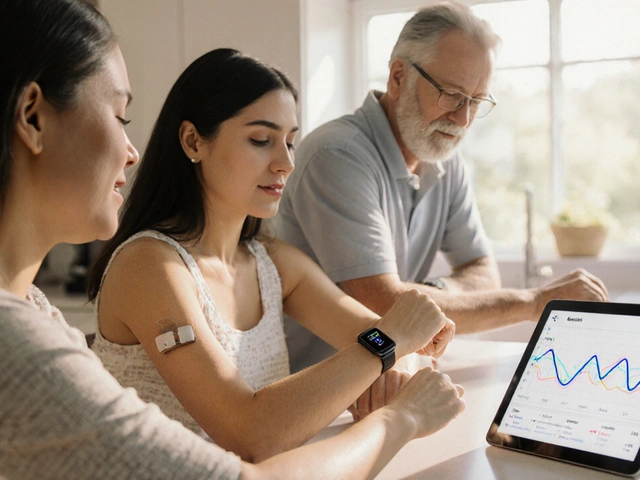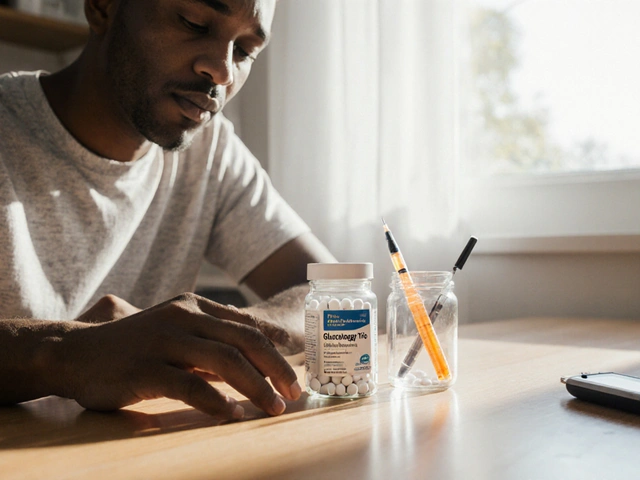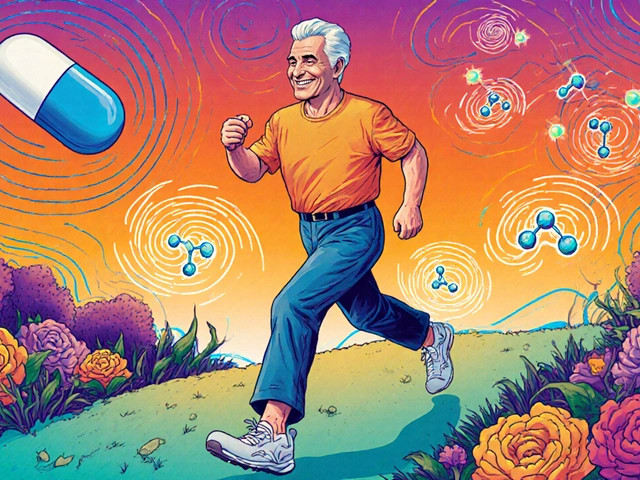Statin Exercise Safety Calculator
Personalized Risk Assessment
Find out if your exercise routine is safe while on statins based on your specific medication and activity.
Millions of Americans take statins to lower cholesterol and protect their hearts. But for many, a nagging side effect makes it hard to stay active: muscle pain. If you’ve been told to exercise for your heart but now feel sore, weak, or stiff after walking or lifting weights, you’re not alone. The big question isn’t whether you should stop moving-it’s how to move safely while on statins.
Statins and Muscle Pain: It’s Not All in Your Head
Statins work by blocking an enzyme your liver uses to make cholesterol. But that same enzyme is also involved in making coenzyme Q10 (CoQ10), a compound your muscles need to produce energy. When statins lower CoQ10 by up to 40% within weeks, your muscles can struggle during physical activity. This isn’t just soreness from a hard workout-it’s a biological ripple effect.
Studies show 5% to 10% of statin users report muscle pain in clinical trials. But in the real world, that number jumps to nearly 30%. Why the gap? Many people stop taking statins because they feel bad-and never tell their doctor. Others assume the pain is just aging or overtraining. The truth? Statin-related muscle symptoms (SAMS) are real, measurable, and often misunderstood.
Exercise Isn’t the Enemy-But Intensity Matters
You’ve heard it a hundred times: exercise prevents heart disease. That’s still true-even if you’re on statins. But not all exercise is created equal when it comes to muscle stress.
A 2023 study in the Journal of the American College of Cardiology followed 105 adults: 35 on statins with muscle pain, 35 on statins without pain, and 35 not taking statins. Everyone did 30 minutes of moderate cycling. Results? No significant spike in creatine kinase (CK), a key marker of muscle damage, in any group. That means moderate exercise doesn’t worsen statin-related muscle injury.
But push harder-like doing HIIT, heavy weightlifting, or downhill running-and things change. A 2016 study found that eccentric exercise (think lowering a dumbbell slowly or running downhill) caused CK levels to jump 300% in statin users, compared to 200% in those not taking statins. That’s a big difference when your muscles are already working harder to make energy.
Long-distance walking is safer than you think. In the famous 4Days Marches in the Netherlands, participants walked 30-50 kilometers a day for four straight days. Statin users had the same muscle soreness and CK levels as non-users. That’s proof that duration isn’t the problem-it’s intensity and type.
Not All Statins Are Created Equal
Some statins are more likely to cause muscle trouble than others. Why? It comes down to chemistry.
Lipophilic statins-like atorvastatin (Lipitor), simvastatin (Zocor), and lovastatin-can easily slip into muscle cells. That’s why high-dose atorvastatin (80 mg/day) increased CK levels by 11.3% in the STOMP trial, even in people who didn’t feel any pain. The FDA’s adverse event data shows atorvastatin 80 mg carries a 10.5-fold higher risk of severe muscle injury than pravastatin.
Hydrophilic statins-like pravastatin (Pravachol) and rosuvastatin (Crestor)-don’t enter muscle tissue as easily. That’s why switching from simvastatin to rosuvastatin helped marathon runner John Davis keep running without pain. For many, just changing statins reduces muscle symptoms by 65%.
And dosage matters. A 20 mg dose of simvastatin cuts VO2 max gains by nearly 7% during endurance training, according to a 2013 study. Lower doses often mean fewer side effects and better exercise results.

When Muscle Pain Is Statin-Related (Not Just Exercise)
How do you know if your soreness is from statins or your last workout? Timing is everything.
- Statin pain: Starts within 30 days of starting or increasing the dose. Feels like constant dull ache, often in shoulders, thighs, or calves. Doesn’t go away after rest. Gets worse with any movement.
- Exercise pain: Comes on during or right after a specific workout. Feels like tightness or burning. Improves within 2-3 days. Returns only if you repeat the same activity.
One man in his 60s started simvastatin and noticed his calves felt heavy after walking. He thought it was just getting older. But when he stopped the statin for two weeks, the pain vanished. When he restarted it, the pain came back in three days. That’s classic SAMS.
What to Do If You Have Muscle Pain
Don’t quit exercise. Don’t quit your statin. But do make smart changes.
1. Start slow. Walk 10-15 minutes a day at a pace where you can talk but not sing. Increase by 5 minutes per week. Use a heart rate monitor-keep it at 40-70% of your max (220 minus your age).
2. Avoid high-risk workouts. Skip HIIT, heavy eccentric lifts (like slow squats or Nordic curls), and long downhill runs until your symptoms stabilize.
3. Talk to your doctor about switching. Ask if you can try rosuvastatin or pravastatin. Or reduce your dose. Some people do well on every-other-day dosing, which cuts muscle side effects by 58%.
4. Consider CoQ10. A 2023 meta-analysis found that taking 200 mg of CoQ10 daily improved muscle strength and reduced pain in 68% of statin users with SAMS. It’s not a magic pill, but it helps fill the gap statins create.
5. Monitor your numbers. If your CK level hits 1,000 U/L or higher (5x the normal limit), pause intense exercise and get checked. Rhabdomyolysis-a rare but dangerous breakdown of muscle tissue-is possible, especially with high-dose statins and extreme exertion. Cyclist Maria Rodriguez ended up in the hospital with CK levels over 12,000 U/L after combining simvastatin with intense training. That’s a warning sign.
The Bigger Picture: Why You Shouldn’t Stop Moving
Some people stop exercising because they’re scared of muscle damage. But here’s the truth: not moving is far riskier.
Statins reduce heart attacks by 25-35% in high-risk people. But exercise reduces them by 30-50%. When you stop moving, you lose that protection. A 2024 Harvard Health report found people who exercised regularly before starting statins were 37% less likely to develop muscle pain. That’s because their muscles were already strong and efficient.
Even if statins slightly reduce your fitness gains-like lowering VO2 max by 7%-you still get 80-90% of the benefit. That’s enough to cut your risk of dying from heart disease. And for most people, the trade-off is worth it.
What’s Next? Personalized Plans Are Coming
Doctors are starting to look beyond one-size-fits-all advice. A gene called SLCO1B1 was linked in 2023 to a 2.3-fold higher risk of muscle pain during exercise in statin users. If you have this variant, even low-dose statins can cause trouble.
By 2030, genetic testing may guide your statin choice and exercise plan. Until then, the best approach is simple: move smart, listen to your body, and work with your doctor to find your sweet spot.
Statin therapy isn’t going away. By 2026, 45 million Americans will be on them. But so will exercise. The goal isn’t to choose between the two. It’s to find how to do both safely-so your heart stays strong, your muscles stay functional, and you keep living well.
Can I still lift weights if I’m on statins?
Yes-but avoid heavy eccentric lifts like slow squats, Nordic curls, or lowering weights too slowly. These movements cause the most muscle damage. Stick to moderate weights with controlled, balanced movements. If you feel deep, persistent soreness that lasts more than 48 hours, scale back and talk to your doctor.
Does taking CoQ10 help with statin muscle pain?
Many people report less pain and better energy after taking 200 mg of CoQ10 daily. A 2023 meta-analysis showed a 68% improvement rate in muscle symptoms. It won’t fix everything, but it addresses the root cause-statins lowering your body’s natural CoQ10. Talk to your doctor before starting, especially if you’re on blood thinners.
Should I stop statins if I get muscle pain?
Don’t stop without talking to your doctor. Muscle pain doesn’t always mean you need to quit statins. Often, switching to a different statin (like rosuvastatin), lowering the dose, or adjusting your exercise routine solves the problem. Stopping statins without a plan increases your risk of heart attack or stroke.
Is walking safe with statin muscle pain?
Walking is one of the safest exercises for statin users. Studies show even long-distance walking (30-50 km/day over several days) doesn’t raise muscle damage markers more in statin users than non-users. Start with 10-15 minutes daily and build up. If your pain improves with walking, that’s a good sign your body can handle it.
Can statins make me less fit over time?
Yes, in some cases. High-dose lipophilic statins like atorvastatin 80 mg can reduce mitochondrial function by up to 15%, which may limit your ability to improve endurance. VO2 max gains can drop by 7% with simvastatin. But even with that reduction, you still get most of the heart benefits from exercise. The key is choosing the right statin and keeping your activity consistent.
When should I get my creatine kinase (CK) levels checked?
If you’re starting a new exercise routine or changing your statin, get a baseline CK test. Then check again 24-48 hours after a new or intense workout. If your CK level exceeds 1,000 U/L (5x the upper limit), stop intense exercise and consult your doctor. Normal range is 30-200 U/L. Levels above 5,000 U/L raise concern for rhabdomyolysis.
Final Takeaway: Move Better, Not Harder
You don’t need to run marathons or lift heavy to protect your heart. You just need to move consistently-without pushing your body past its limits. Statins are powerful tools. Exercise is even more powerful. The goal isn’t to choose one over the other. It’s to make them work together. Find your pace. Listen to your body. Adjust your meds if needed. And keep walking, biking, or swimming-because your heart still needs you to move.








November 20, 2025 AT 07:59
Destiny Annamaria
I was on Lipitor for 3 years and thought my leg soreness was just from chasing toddlers all day. Turns out? Statins. I switched to pravastatin and started walking 20 mins a day. No more constant ache. I’m not saying it’s magic, but it’s life-changing. Also, CoQ10? I take it with my breakfast now. My energy’s back. 🙌
November 21, 2025 AT 10:46
Ron and Gill Day
Oh please. Another ‘statins are evil’ clickbait article. You’re telling me people who lift weights and take statins can’t be athletes? I’ve seen guys on 80mg atorvastatin crush deadlifts. Your ‘study’ is garbage. CoQ10 is just a fancy vitamin. Stop scaring people into quitting meds that save lives.
November 22, 2025 AT 00:12
Alyssa Torres
Okay, but let’s talk about the emotional toll. I cried last week because I couldn’t climb stairs without my thighs burning. I felt like a failure. Then I found this post. I switched from simvastatin to rosuvastatin. Cut my dose in half. Started walking with my dog every morning. I’m not ‘fixed’-but I’m not broken anymore. To anyone feeling guilty for slowing down: you’re not lazy. You’re adapting. And that’s strength. 💪❤️
November 23, 2025 AT 11:18
Summer Joy
COQ10? LOL. That’s just a placebo with a price tag. And ‘moderate exercise’? What does that even mean? My cousin did 50kms for 4 days on statins and ended up in ICU. You’re giving people false hope. Also, why do doctors always blame the patient? Maybe it’s the damn pills. 🤡
November 23, 2025 AT 22:38
Aruna Urban Planner
The pharmacokinetic profile of lipophilic statins facilitates greater myocyte penetration, thereby increasing the likelihood of mitochondrial dysfunction via CoQ10 depletion. Hydrophilic analogues demonstrate reduced cellular uptake, correlating with lower incidence of SAMS. The SLCO1B1 polymorphism further modulates hepatic clearance-genotype-guided prescribing remains underutilized in primary care. Ergo, personalized exercise prescription must account for statin class and metabolic phenotype.
November 25, 2025 AT 02:20
Nicole Ziegler
walking > everything 🚶♀️❤️
November 25, 2025 AT 21:42
Bharat Alasandi
bro i was on 40mg simvastatin and couldnt even carry groceries. switched to rosuvastatin 10mg and started cycling slow. no pain. no drama. my knees feel better than they did in college. also, coq10 is legit. 200mg daily. no magic, just science. stay consistent, not extreme.
November 27, 2025 AT 19:28
Kristi Bennardo
This article is dangerously misleading. The FDA has issued multiple black box warnings on statin-induced rhabdomyolysis. To suggest that ‘walking is safe’ without mandatory CK monitoring is irresponsible. Patients are being manipulated into believing they can ‘out-exercise’ pharmacological toxicity. This is not medicine-it’s wellness propaganda.
November 29, 2025 AT 12:45
Shiv Karan Singh
you all are sheep. statins are a scam. cholesterol isn't bad. heart disease is caused by sugar and stress. your doctor is paid by big pharma. coq10? nah, just stop taking the pills. and walking? lol, that's not exercise. real exercise is lifting. you're all weak.
November 30, 2025 AT 10:43
Ravi boy
man i took atorvastatin for 2 years and my legs felt like concrete. switched to pravastatin and started walking 30 mins. no more pain. coq10? i dont know if it helped but i take it anyway. also my doctor said dose matters. 20mg is fine. 80mg? no thanks. also dont stop statins without talkin to doc. my uncle had a heart attack after quitin. dumbass.
December 1, 2025 AT 05:29
Matthew Karrs
They’re hiding the real data. The clinical trials exclude people who actually get muscle pain. The 5% number? That’s the tip of the iceberg. They don’t test people who train hard. They don’t test athletes. They don’t test people who lift. They only test sedentary patients who won’t complain. And CoQ10? They don’t want you to know it works because it’s cheap. This is all about profits. I’m not taking anything anymore. My heart is fine. I eat butter now.
December 1, 2025 AT 19:41
Destiny Annamaria
Bro, I get it. You think I’m dumb for taking CoQ10. But when you’ve spent weeks too sore to hug your kid, you try everything. I didn’t stop my statin. I didn’t stop walking. I just added the supplement. And now I can pick up my niece without my legs screaming. So yeah, I’ll take my ‘placebo’ with a side of peace of mind. 😊